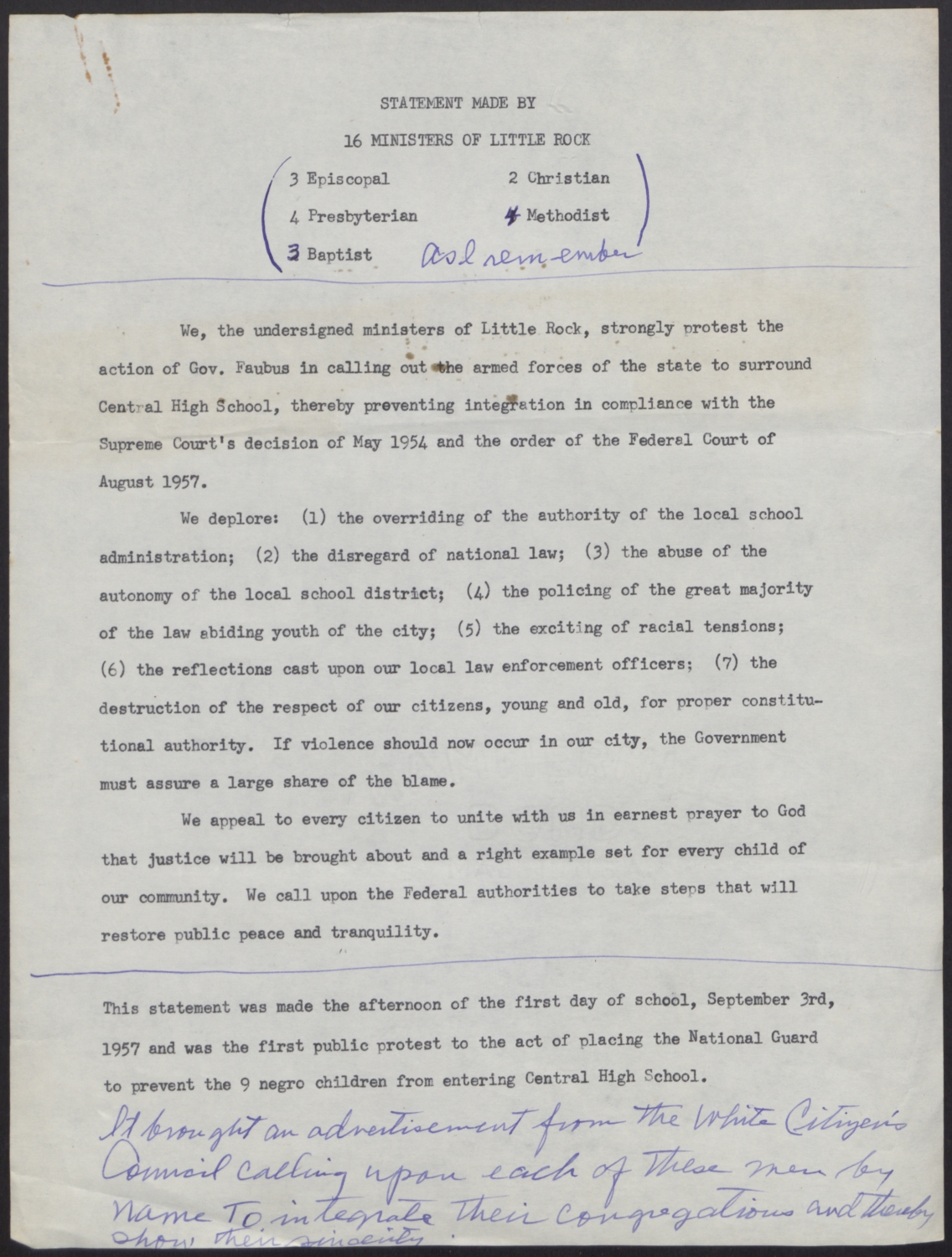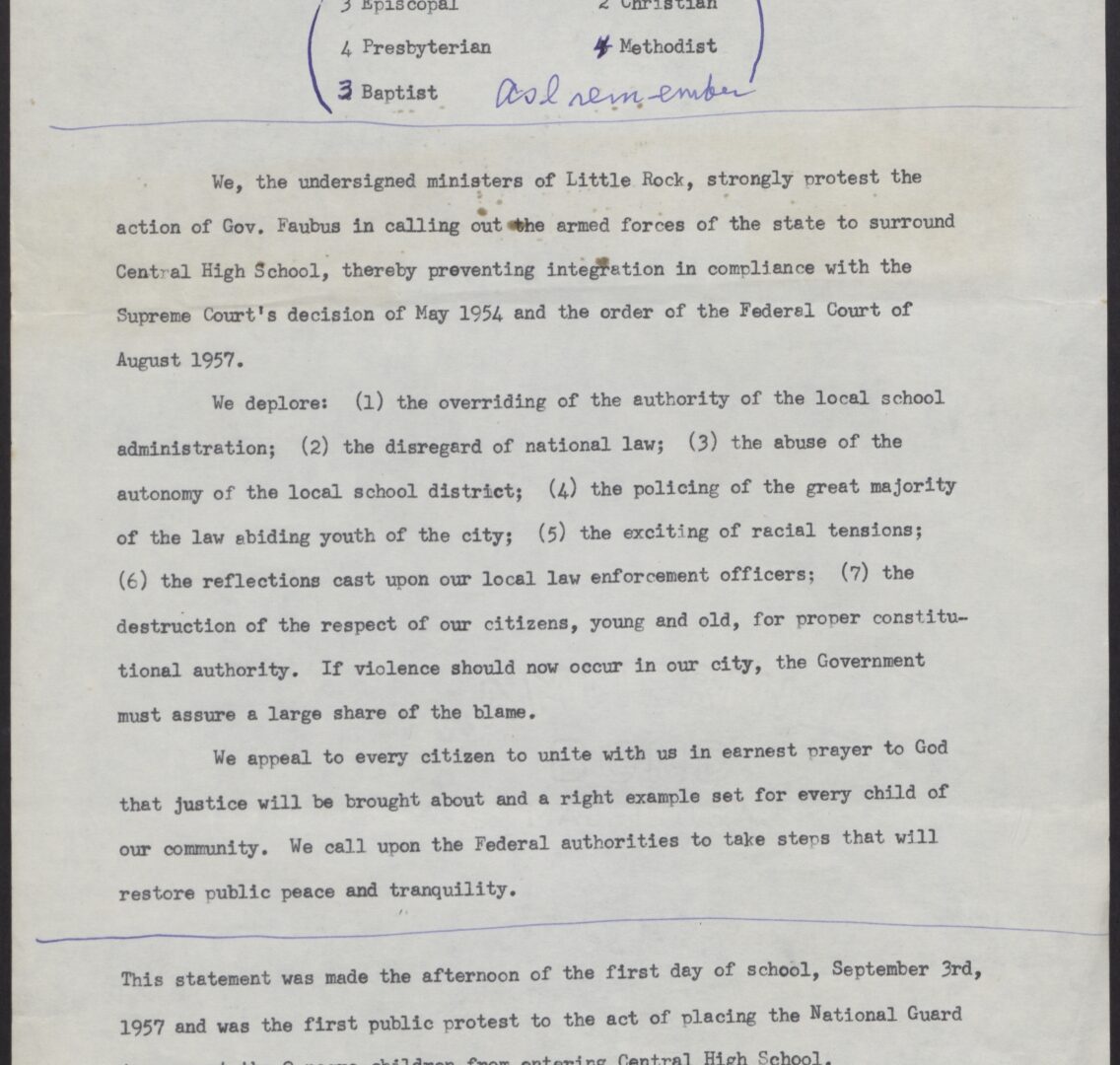White Religious Leaders and the Little Rock Crisis
Introduction
In 1954, nearly a century after a formal abolition of slavery in the United States, Brown v. Board of Education of Topeka, one of the most important Supreme Court decisions in US history, declared that segregation in public schools was unconstitutional. It was a momentous victory for civil rights activists and all black Americans. However, the decision sparked outrage among many white Americans, particularly in the South. It was evident that law alone was not enough to change deeply rooted racial prejudices.
One of the greatest challenges posed by Brown v. Board of Education was the lack of any specific desegregation requirements or guidelines. That opened space for segregationists to resist and fight against integration efforts. In 1955, the Little Rock school board accepted a plan of gradual integration presented by superintendent Virgil Blossom. According to the plan, Little Rock schools were to begin integration process in the fall 1957. However, when nine African American students enrolled in previously all white Little Rock Central High School appeared in front of their new school on September 4, 1957, they were met by a white angry mob and the Arkansas National Guard. Governor of Arkansas Orval Faubus called the latter not to protect the black students’ constitutional right to equal education but to block them from entering the school building.
In this activity, you will examine an appeal signed by sixteen Little Rock Christian leaders who responded to these events in the early days of what is today known as the Little Rock Crisis.
Activity Questions

“Statement Made by 16 Ministers of Little Rock,” September 3, 1957. Bishop Robert R. Brown papers (UALR.MS.0081)
Handwritten: [Top] As I remember [Bottom] It brought an advertisement from the White Citizens’ Council calling upon each of these men by name to integrate their congregations and thereby show their sincerity.”
- Who are the sixteen men who signed this statement?
- What do the sixteen men who signed this statement protest?
- How do the sixteen men understand the ongoing crisis in Little Rock? Examine the seven points in the second paragraph. Each of them offers a clue on how the statement’s authors understood the events at Central High.
- When was this statement made? See the timeline of the Little Rock Crisis (https://www.nps.gov/chsc/learn/historyculture/timeline.htm). How does this statement fit in the timeline of the 1957 events?
- The handwritten note at the bottom reads: “It brought an advertisement from the White Citizens’ Council calling upon each of these men by name to integrate their congregations and thereby show their sincerity.” Research the role of white citizens’ councils in the crisis. Why do you think this council called the sixteen ministers to “integrate their congregations”? Why would a white citizens’ council make that appeal if their main goal was to oppose integration?
- The comment about the white citizens’ councils calling the men who signed this statement to integrate their congregations suggest that the sixteen ministers were white. Do you think that sixteen is a big or small number? If you are not sure, research how many residents and how many white congregations Little Rock had in the 1950s.
- Historians have concluded that most white religious leaders in Little Rock either opposed integration or stayed silent during the Little Rock Crisis and other civil rights struggles. Those who supported integration and voiced their support for the Little Rock Nine were a minority. What does it tell us about white Christian leaders in Little Rock at the time? What does it tell us about the sixteen men who signed this statement?
Primary Sources
To learn more about the primary sources featured in the activities above, click the following links:
Arkansas Social Studies Standards
Arkansas History, Grades 7 – 8
- Strand: History Content Standard 7: Students will examine the impact of historical events and people on the development of Arkansas.
- H.7.AH.7-8.8 Analyze social, economic, and political effects of the Civil Rights Movement on various regions in Arkansas from multiple perspectives (e.g., integration, state legislation)
Arkansas History, Grades 9 -12
- Strand: Era 5: World War II Through the Civil Rights Era 1941-1967
- Content Standard 5: Students will analyze factors that influenced the perspectives of Arkansans from World War II through the Civil Rights Era.
- Era5.5.AH.9-12.4 Analyze the social, economic, and political effects of the Civil Rights Movement in various regions of Arkansas using primary and secondary sources from multiple perspectives (e.g., segregation; voting; integration of Fayetteville, Hoxie, and Little Rock School Districts; federal and state legislation)
US History Since 1890, Grades 9 – 12
- Strand: Era 9: Post-war United States 1945 to Early 1970s
- Content Standard 5: Students will analyze social, economic, and political changes in the United States between 1945 and 1970.
- Era9.6.USH.1 Analyze the roles of individuals, groups, and the government in securing civil rights during the mid-20th century using a variety of primary and secondary sources (e.g., minorities, women, NAACP, federal court cases, legislation, Twenty-fourth Amendment)
- Era9.6.USH.4 Examine domestic policies of the federal government between 1945 and 1970 and the outcomes from multiple perspectives (e.g., New Frontier, Great Society, civil rights, social issues)
- Era9.6.USH.5 Construct historical arguments of long-term effects of social and economic changes occurring during the mid-20th century using available data and multiple sources
Key Terms
Downloadable Guides and Handouts
We encourage K-12 educators to use History Alive: Virtually! in a way that will best match their classroom needs. The “Exercise” handout includes a complete exercise as featured on this website, the “Primary Sources” handout includes only primary sources used in the exercise, and the “Questions” handout includes analytical questions from the exercise but is editable and can be easily changed to best match students’ needs.
White Religious Leaders and the Little Rock Crisis – Exercises
White Religious Leaders and the Little Rock Crisis – Primary Sources
White Religious Leaders and the Little Rock Crisis – Questions

